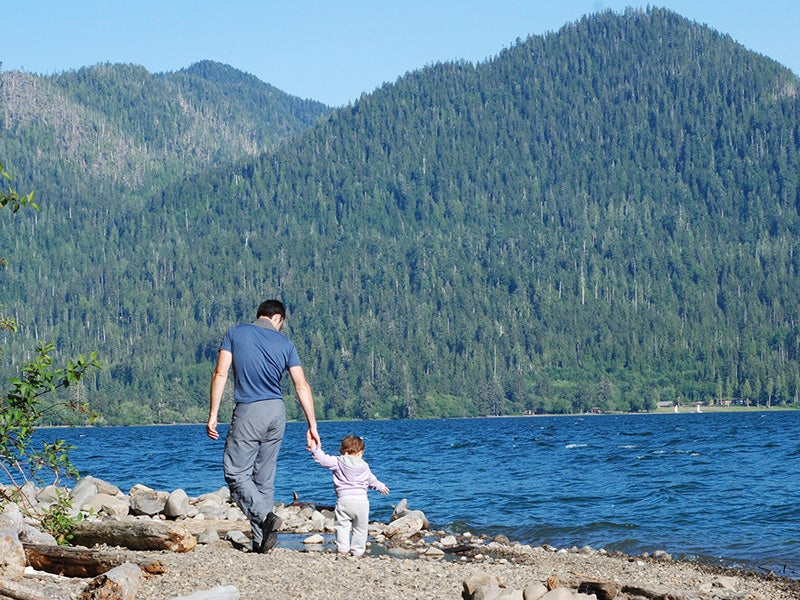Roadless Rule – A Victory We Must Keep on Winning
A decade after the Roadless Rule’s adoption, and years into the Obama administration, we’re still fighting to protect roadless areas.

This page was published 12 years ago. Find the latest on Earthjustice’s work.
Wouldn’t it be great if we could be done protecting Forest Service roadless areas because they were all protected? If you have followed the tortured history of President Clinton’s national Roadless Area Conservation Rule—which Earthjustice defended for more than a decade, with success—you’d be forgiven for thinking that 2001 rule settled the matter.
Sadly, the dead hand of the Bush administration—and the living hands of some inside the Forest Service who still don’t believe roadless areas should be protected—continue to have a grip on agency policy. First, a reminder on why it’s important to protect roadless lands.
By the late 1990s, logging, mining and other extractive uses as well as forest managers had punched roads on national forest lands just about anywhere it was easy to do so. The Forest Service continued to OK new road construction even though it had a multi-billion dollar backlog to maintain the network it had. And what a network—386,000 miles of road—a distance that would stretch to the moon and more than halfway back.
Even aside from maintenance, this road network has costs. Roads can, and often do, fragment habitat, cause erosion, disrupt natural hydrology, degrade watersheds used for drinking water supplies, spread noxious weeds, worsen fire danger, create avenues for wildlife poaching and theft of archeological resources, destroy wilderness character, disrupt quiet recreation, and threaten imperiled species. Hence the justification for the Roadless Rule, which survived all of the Bush administration’s many attempts to dismantle it.
But a decade after the Roadless Rule’s adoption, and five years into the Obama administration, we’re still fighting to protect roadless areas. In Wyoming and Arizona, forest supervisors in 2012 bowed to pressure from local extractive interests, agreeing to consider managing entire forests as if the Roadless Rule—the law of the land—did not exist.
While the Obama administration is unlikely to approve such plans, we’ll be watching those planning decisions closely. In Colorado, President Obama’s July 2012 decision to carve out a 20,000-acre loophole for coal mines in a “special,” weaker state-wide version of the Roadless Rule paid immediate dividends for industry.
Beaver lodge in Sunset Trail Roadless Area.
(Ted Zukoski)
Just weeks after the weaker Colorado rule was adopted, the administration OKed a 3-square-mile coal lease inside the Sunset Roadless Area, predicted to result in the bulldozing of 6+ miles of road and nearly 50 drilling pads. Local Forest Service staff worked overtime to get the mine expansion approved and derided the roadless area as “crappy.” Judge yourself by looking at these photos.
Earthjustice has sued to set aside the lease. Our challenge should be fully briefed in federal court in Colorado early next year. Looming on the horizon are more threats from miners and also oil companies, these to the Pilot Knob roadless area a few miles from the Sunset roadless area in western Colorado. Pilot Knob provides habitat for black bear, mountain lion, mule deer and elk, moose and endangered lynx, bald eagle and Northern goshawk. At elevations up to 10,000 feet, hikers and hunters can find ridge after ridge of lush aspen forests, clear streams and stunning views of the Ragged Mountains.
The Ragged Mountains viewed from the Buck Mesa Trail. (Jim Ramey Photo)
But roadless values may not be important enough for the Obama administration to say “no” when extractive industry executives say, “I want!” The Forest Service is now preparing to approve roads for a coal mine in the southern part of this 17,000-acre area. Some citizens are pushing back.
But wait! There’s more! The Forest Service is also now weighing a proposal that would rip the heart out of the Pilot Knob roadless area, a ‘master development plan’ that would create an industrial landscape for a natural gas project by cramming 50 wells on 25 scraped drilling pads into the central 10 square miles of the area. This bad idea is a leftover from the Bush administration, which attempted to sneak through oil and gas leases in the area after the Roadless Rule was adopted.
Will the Obama administration bend to give the drillers what they want? Or will it finally stand up for a Colorado roadless area? One thing’s for sure. The battle for roadless areas is, sadly, not over yet.
Earthjustice’s Rocky Mountain office protects the region’s iconic public lands, wildlife species, and precious water resources; defends Tribes and disparately impacted communities fighting to live in a healthy environment; and works to accelerate the region’s transition to 100% clean energy.